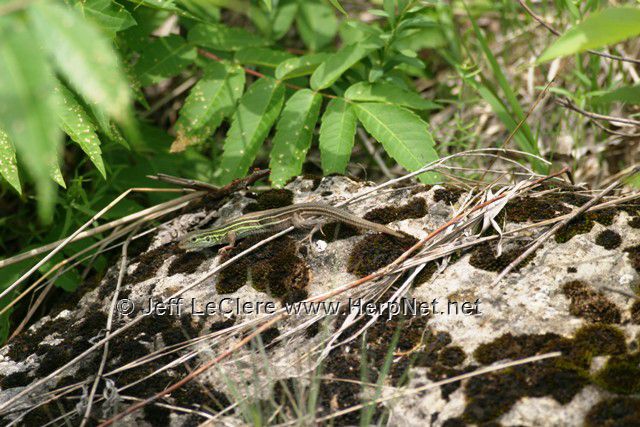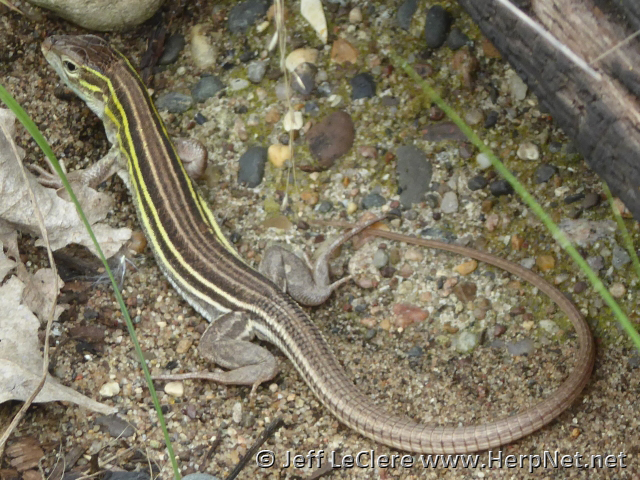Six-lined Racerunner (Aspidoscelis sexlineata)
by Jeff LeClere
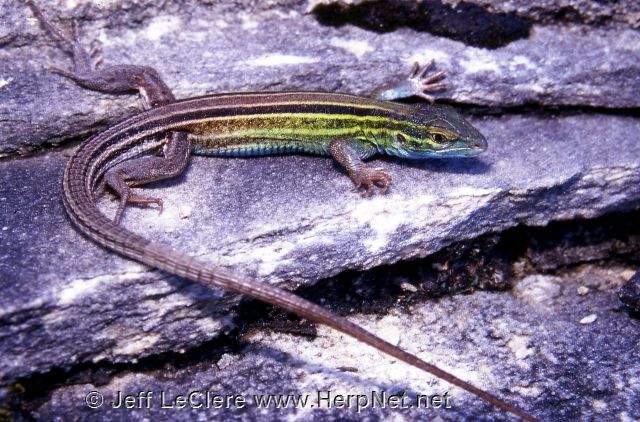
Status
Species of Greatest Conservation Need.The former scientific name for this lizard was Cnemidophorus sexlineatus.
Description
The six-lined racerunner is Iowa’s fastest lizard reaching a length of 9 1/2 inches (Conant and Collins, 1991). A colorful lizard that will not be as difficult to distinguish as the other Iowa species. The scales are rougher than skinks, but small on the dorsum becoming larger and more rectangular on the belly. There is a patch of enlarged scales on both forearms and the scalation on the tail is larger and ridged giving the tail a rougher feeling instead of smooth as in skinks.
In males, the ground color may be green with blue on the head and belly. Females and young are usually brown. Both sexes have six narrow light stripes down the back and sides. The snout is more pointed and the legs are longer than in skinks.
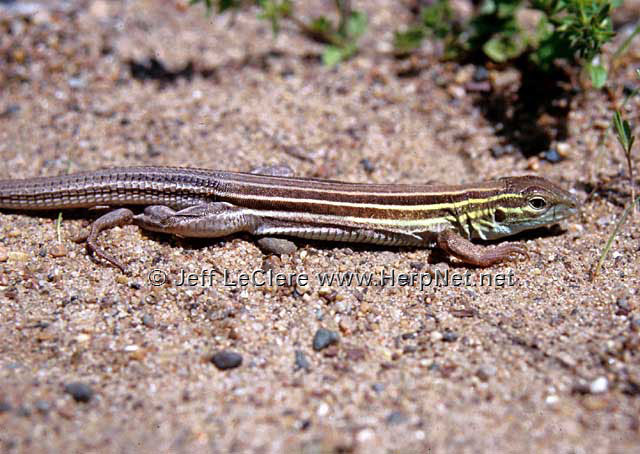
Subspecies
The only subspecies of six-lined racerunner in Iowa is the prairie racerunner, Aspidoscelis sexlineata viridis.
Range
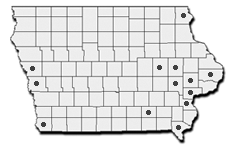
Racerunners are found in all the counties bordering the Mississippi River in eastern Iowa northward into southeastern Minnesota. They also range north into Iowa via the Missouri River in western Iowa, but only halfway up the state (LeClere 2013).
Habitat
Racerunners come from sandy prairie areas, open rocky bluff prairies similar to good milk snake, ringneck, racer, and rattlesnake habitat on the eastern side of the state. In western Iowa, they are found in the open, dry, rolling, Loess Hills.
Habits
Racerunners may wait until May to begin their seasonal activity period. Racerunners bask atop rocks or logs and actively forage for their food. They are diurnal, but they often take refuge under rocks or logs during the hottest parts of the day in mid-summer, however, somewhat less so than the skinks. They are accomplished burrowers, and racerunners especially, may construct burrows with entrances that form shallow dugouts under rocks or similar cover.
Breeding occurs in spring. The male grasps the skin of the female’s neck during copulation. I have seen gravid females in late May in Iowa. A friend of mine and I have observed a female in Louisa County so distended with eggs that one could easily count the number inside. They are oviparous and the eggs hatch in August. Prairie racerunners lay about a half dozen eggs in shallow burrows in the sand. The female does not stay with the eggs. The young are about 1 1/4 inches at hatching.
All of Iowa’s lizards are quick and rely on speed to escape when they are out and about. Prairie racerunners have been clocked at speeds of 18 miles per hour (Vogt, 1981). The warmer they are, the faster they are. During the heat of the day it is nearly impossible to catch a specimen on the run. It is better to wait until early morning or near dark and catch them by flipping rocks or other cover. I was chasing one on a sandy dike in southeastern Iowa in the heat of the day in summer. The river was flooded and the only way I caught this particular specimen was by chasing it into the flooded area. It was very warm to the touch after foraging in the hot sun.
They can readily detach their tails regenerating a new one, but it is a bit more difficult to induce them to drop their tails than the skinks. These lizards live in small colonies in suitable habitat, usually sandy goat prairies high in the bluffs. Iowa’s lizards overwinter underground in burrows they dig. Adult racerunners usually begin dormancy in late August, but the young remain active until September.
Food
All five species of Iowa’s lizards eat small invertebrates such as crickets, grasshoppers, beetles, spiders, caterpillars, which they chase down and eat. They mash their food up with their strong jaws before swallowing their prey. Prairie racerunners are voracious and may consume larger prey items, especially at higher temperatures.
